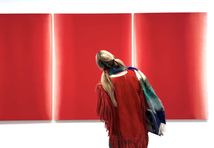Olivia Laing on the Art of Being Alone
- The Courtauldian
- Aug 11, 2019
- 3 min read
This article was previously published in Issue 20, ISLANDS (March 2019).
Following a difficult breakup and a transatlantic move to New York City, Olivia Laing finds herself in the midst of a crisis – alone in New York and experiencing poignant isolation. Her remedy? Art. In a sharp non-fiction titled ‘The Lonely City: Adventures in the Art of Being Alone’, Laing gently rips to shreds any of the New York glamour and glitz installed upon us by the likes of Nick Carraway or Carrie Bradshaw. Instead, she offers an exploration into the solitary lives of several of New York’s twentieth-century artists as a balm for wounds of loneliness – after all, what is relatability if not a great comfort?

Illustration by Nia Thomas
The book is structured in chapters, each dedicated to the analysis of an artist: Zoe Leonard, Henry Darger, Andy Warhol, David Wojnarowicz, and Valerie Solanas are among those dissected by Laing. Nothing is off the table when it comes to identifying their personal brands of solitudes. Laing delves into childhood traumas, abandonment, AIDS, voyeurism and other factors of isolation. Each passage is an opportunity to frame an artist as an exemplification of a particular aspect of loneliness: Wojnarowicz the solitary outcast, Warhol a misfit, Hopper the bitter painter. The Lonely City’s ability to combine examples of artists with psychological research conducted by leaders in the field is a powerful approach and solidifies many of Laing’s arguments, without drowning out the sensitivity of her writing. Paragraphs, sentences and chapters flow in a continuous and evolving harmony. There is a sense of constant fine-tuning throughout the book as if, whilst acquiring knowledge and deepening her research, Laing is having to shift her perspective. Her use of language is seamless and eloquent as she strikes into the perfect balance of creative and informative writing making for a very enjoyable read.
Perhaps most poignant of all her passages is the analysis of Valerie Solanas, the woman who shot Andy Warhol (an event that came to tragically overshadow her own achievements as a writer and social activist). Once described by Avital Ronell as ‘a loner’, Solanas had no followers or supporters. As put in the book, she arrived too late or too early on every scene. The passages on her battle for recognition are as gripping as they are painful to read but they encompass well the underlying message: solitude is often a by-product of societal rejection. And it begs the question of our own contribution to this; how often have we personally been implicated as a catalyst to isolation?
Laing places us both in the seat of the lonely and that of their excluders – we observe their solitude from the safety of our book without needing to commit to it. We join Wojnarowicz’s struggle against the climate of fear surrounding the AIDS crisis; we empathise with Warhol; we experience the arrival of the internet and Josh Harris’ dauntingly familiar We Live in Public; and, paradoxically, we begin to participate in a collective experience of loneliness.
In our often over-commercialised art world, it was refreshing to read about artistic practice as a means of self-recovery rather than societal or financial success. The core of the book really lies not in the exploration of solitude but in art as a means of overcoming it. The repeated imagery of artists Zoe Leonard stitching fruit together, Darger meticulously collecting string, and Warhol’s time capsules, all transition from artistic practices to coping mechanisms in our eyes. In the midst of all the isolation born from society, there is comfort in the notion that solitude is not selective and can be experienced by all. The Lonely City opens us to the suggestion that artistic expression does not result in automatic inclusion, nor is it the definitive cure to isolation, but it’s a good start.












Comments